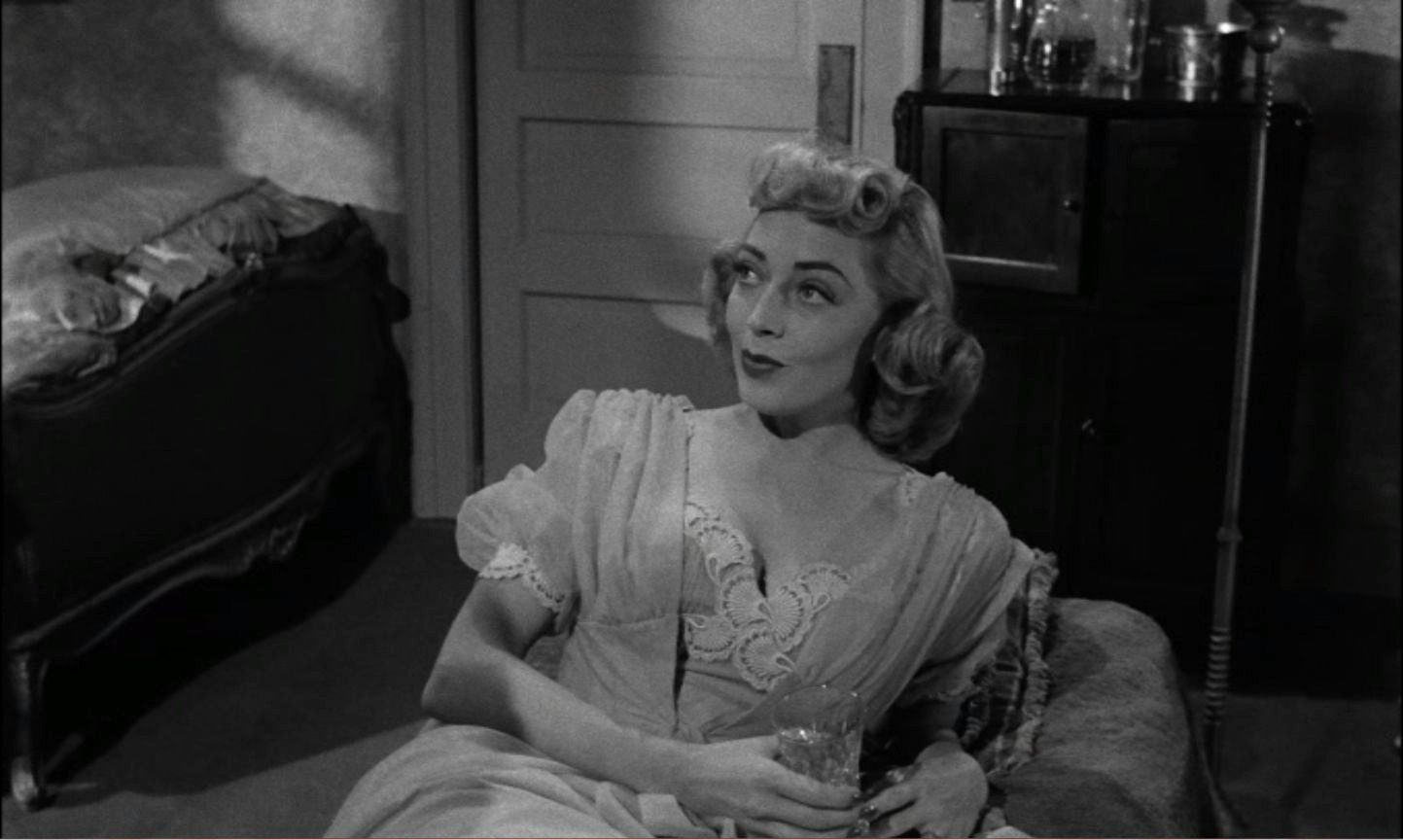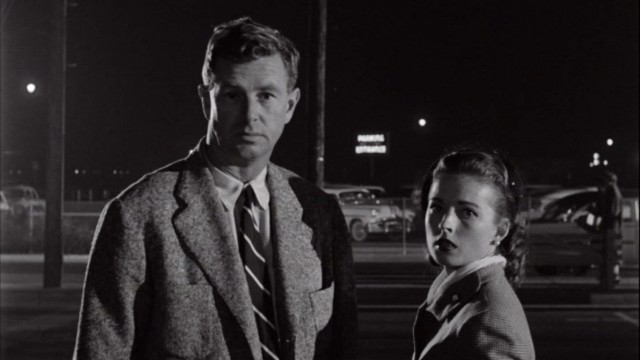Gerald Fried’s score comes stomping in, the credits appear in simple block capitals over an elegantly composed sequence of a racetrack, leading up to the start of the race, then the voiceover, with none of the abstraction of Fear and Desire or the introspection of Killer’s Kiss, precisely locates us in character, action, and in a story that has already started. The Killing, as Nuke LaLoosh sez, announces its presence with authority. That opening scene serves as an overture, demonstrating the structure, setting, even the camera move that will dominate the next eighty relentless minutes.
This was another jump in Kubrick’s career, and it set some things in place for the rest of it. Kubrick’s films were so singular that it’s easy to overlook how important, necessary even, his collaborators were to him. This is the first Kubrick film where he doesn’t carry a “Directed, Edited, and Photographed by” credit; the great Lucien Ballard (who was uncredited on Laura and would go on to shoot The Wild Bunch, among other films) shot the film here. This was his first film co-produced with James B. Harris, who would partner with him twice more, his first film co-written with the great noir author Jim Thompson, and the first film with several actors who would be back in later films: Joe Turkel, Timothy Carey, and Sterling Hayden. Finally, beginning here and for the rest of his career, all of Kubrick’s films (with the possible exception of 2001, more on this later) were adaptations of preexisting material; Michael Herr would note that Kubrick’s method of adaptation would be to find a good story, and then break it down and use that story as a framework for his own vision. He needed that story first, though.
That last collaboration solved two similar problems that had been in Kubrick’s previous films, and quite possibly in his instincts as a photographer: the problems of story and structure. Kubrick’s great skills as a photographer included the ability to imply, to make us think “what’s next?” but a film has to show us what’s next, and give us a reason for what’s next. Story and structure are similar answers to that question. Story is the reason characters do something next, and structure is the reason we see something next, and The Killing excels at both.
The Killing goes for a simple story–Johnny Clay (Hayden) organizes a racetrack heist–and an elegant structure, what Quentin Tarantino would call the “answers first, questions later” structure, where we see what happens (and the actors convey that it’s important we see it) before we know why it happens. Johnny has a plan, and he reveals to the collaborators only what they need to know, which means it’s less than what we need to know. When it comes to the heist sequence itself, Kubrick and Thompson present the events four different times from the perspective of four characters, and it’s thrilling. We’re always in the position of having to figure out why we’re seeing what we’re seeing. This structure allows Kubrick to do something he did in Fear and Desire: use the same shots again with a different context. It was cheap and distracting there, but here it gives the great detective-story feeling of “oh now I get it.”
It’s a spare, elegant film, and Kubrick directs it sparely and elegantly. There’s no wasted action here and no wasted shots; like a great short story, every moment either advances the action or explains motivation. There’s a great hint of how the film will end in the way the money keeps spilling out of every container; it’s equally as elegant the way that the moment any character warns another about getting greedy, he’ll be the greedy one in the next moment. Unlike Killer’s Kiss, there’s no attempt to ground this in any kind of realistic setting (it’s Los Angeles, and there’s a neat touch of an ad for Lenny Bruce in the background, but neither of those matter); it’s entirely about the characters and the action. Kubrick repeatedly moves the camera horizontally, tracking characters across a space, even when it’s physically impossible for the camera to do that, which heightens the artificial feeling of the story. His skill with composing and framing images never diminishes; in the sequences with Elisha Cook and Marie Windsor, the characters are in a perfectly framed and lit composition, then they get up, move, and end up in another perfectly framed and lit composition, and Ballard shoots this with the darkest, inkiest blacks. All of this is artificial, all of this increases the intensity, and all of this artifice and intensity belongs only to movies.
The artificiality extends to the characters, and that’s not necessarily a bad thing. As much as in Killer’s Kiss, these characters are all noir types, but they’re a lot more effective here because 1) there’s more than three of them, 2) the actors are much better at what they do and especially 3) Jim Thompson wrote the dialogue, which is as zingy and fun as in His Girl Friday or The Thin Man but has that Thompson level of viciousness, especially in the husband-and-wife scenes with Cook and Windsor. (He’s small, she’s blonde, I ain’t saying she’s a gold digger, but. . .well yes I am saying that.) They take their lines so quickly that there’s no realistic way one can be hearing what the other one’s saying, and that’s something we’ll see through all of Kubrick’s films, they way people don’t communicate. That can be darkly, apocalyptically comic (as in Dr. Strangelove) and it can be horrifying (as in The Shining) and it can be otherworldly (as in 2001). Here, it’s funny as all hell and more than a little sad. Windsor’s character, by the way, is a triumph of acting, lighting, and costume design, creating something out of Frank Miller.  Also notable is the amazing Timothy Carey, who just doesn’t look or act like anyone else in our species; with his long face, bizarre line readings, and distinct resemblance to a basset hound, he’s been compared to Nicolas Cage but the closest relative to his performance here is Benicio del Toro in The Usual Suspects. (Gabriel Byrne said of the latter, “look, we don’t want to interfere with anyone’s process but no one can understand a fucking word Benicio is saying,” and that applies here too.)
Also notable is the amazing Timothy Carey, who just doesn’t look or act like anyone else in our species; with his long face, bizarre line readings, and distinct resemblance to a basset hound, he’s been compared to Nicolas Cage but the closest relative to his performance here is Benicio del Toro in The Usual Suspects. (Gabriel Byrne said of the latter, “look, we don’t want to interfere with anyone’s process but no one can understand a fucking word Benicio is saying,” and that applies here too.)
Sterling Hayden’s performance goes beyond the rest, and beyond what it needs to do, and it’s what elevates this movie from a fun puzzle (and it most definitely is that) into something else. His dialogue is as hard-boiled as anyone else’s (his scene with Windsor plays as a sonata for two instruments) and his character is as much of a type (crook just out of prison going for the Big Score), but Hayden gives Johnny Clay a gravity and weariness that no one else has, unless it’s Jay C. Flippen’s Marv, who bankrolls the operation and has a homosexual longing for Johnny. Hayden’s suits don’t fit, he does what he does only out of necessity; there’s nothing cool about this guy; think of him as the anti-Danny Ocean. More than anything, he seems tired all the time. He’s totally believable as someone who’s been in prison for five years and just wants some peace and quiet; when he says to steal big, “because they can put you away for a ten-dollar heist as easily as for a million-dollar job,” it’s resignation, not defiance. We know what we’re seeing here is his only option.
The noir genre runs on that sense of fate, and that’s where The Killing’s stripped-down story and puzzle structure pays off the most. The heist movie’s underlying structure, no matter how it’s dressed up, is “perfect plan goes to shit in action,” because the world keeps throwing wrenches (in this case, horseshoes) into your ordered, logical plan. Kubrick’s clean storytelling, Ballard’s hard-lined images, Thompson’s blade-sharp dialogue, all create an ordered world where Johnny’s plan unravels as elegantly and as mercilessly as it comes together. The feeling isn’t “crime doesn’t pay,” but something deeper than that, more like Lost’s idea of “course correction”: no matter what you do, the universe changes to get you to your destination, and Hayden’s last moment, mercilessly framed by the camera, sells that. Even more than the final line–“what’s the difference?”–the look on his face, so tired and bleak, lets us know that it always had to end this way.
Kubrick would take on so many genres in his career, and as Declan Giggs pointed out, he’d excel in all of them. (I count two of the best war films, two of the best historical epics, one of the best horror films, and one of the best satires on the list.) Maybe one aspect of his success, though, was that no matter what kind of film he made, he never really left the noir genre. No matter the film, you see men with plans and ambitions that the universe keeps tripping up and turning back on them; you hear the dialogue that’s unrealistic and unforgettable; you see the locations that could be anywhere, the archetypal performances; and you see the deep, shadowy cinematography. It’s a genre that comes from a specific place and time (postwar Los Angeles), but Kubrick committed to it and made it work from ancient Rome to modern New York, and The Killing was the source point, the end of his education and the opening of his vision.
Previously: Stanley Kubrick, photographer
Next: Paths of Glory (1957)


